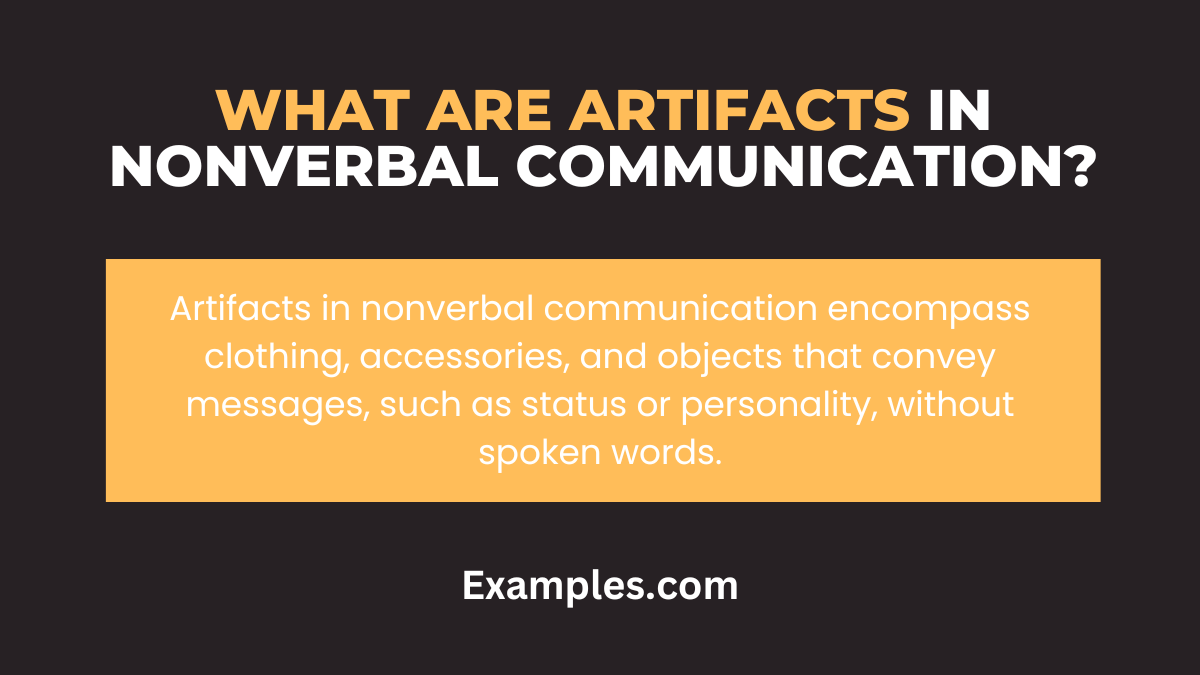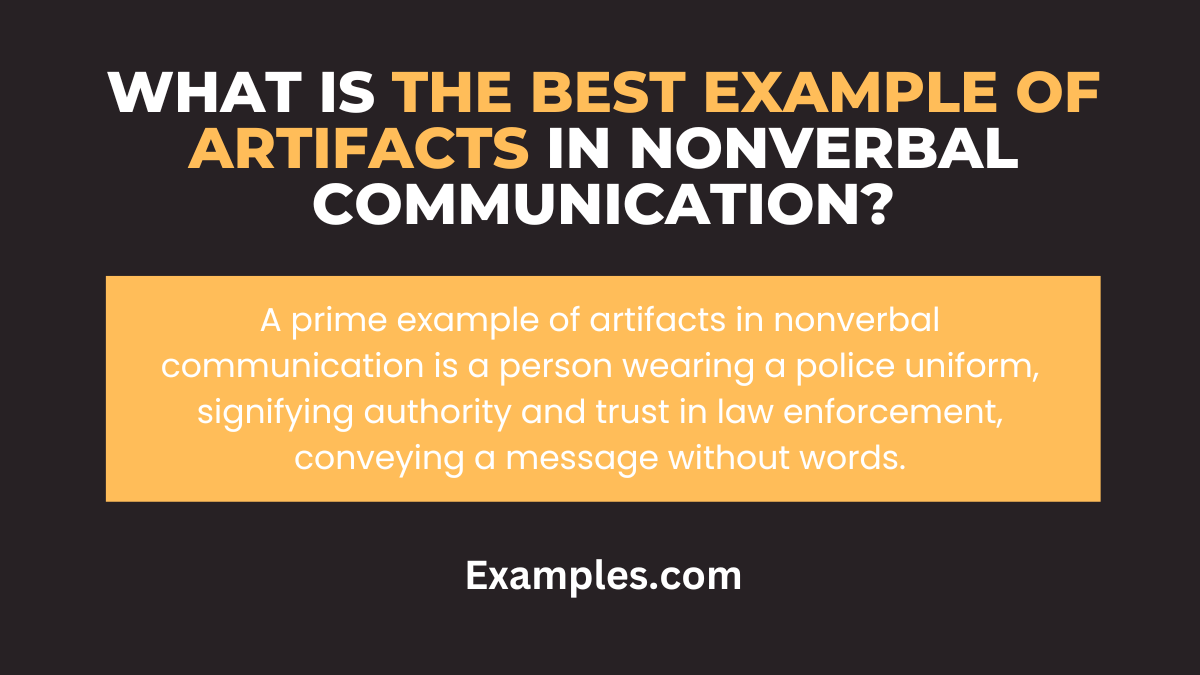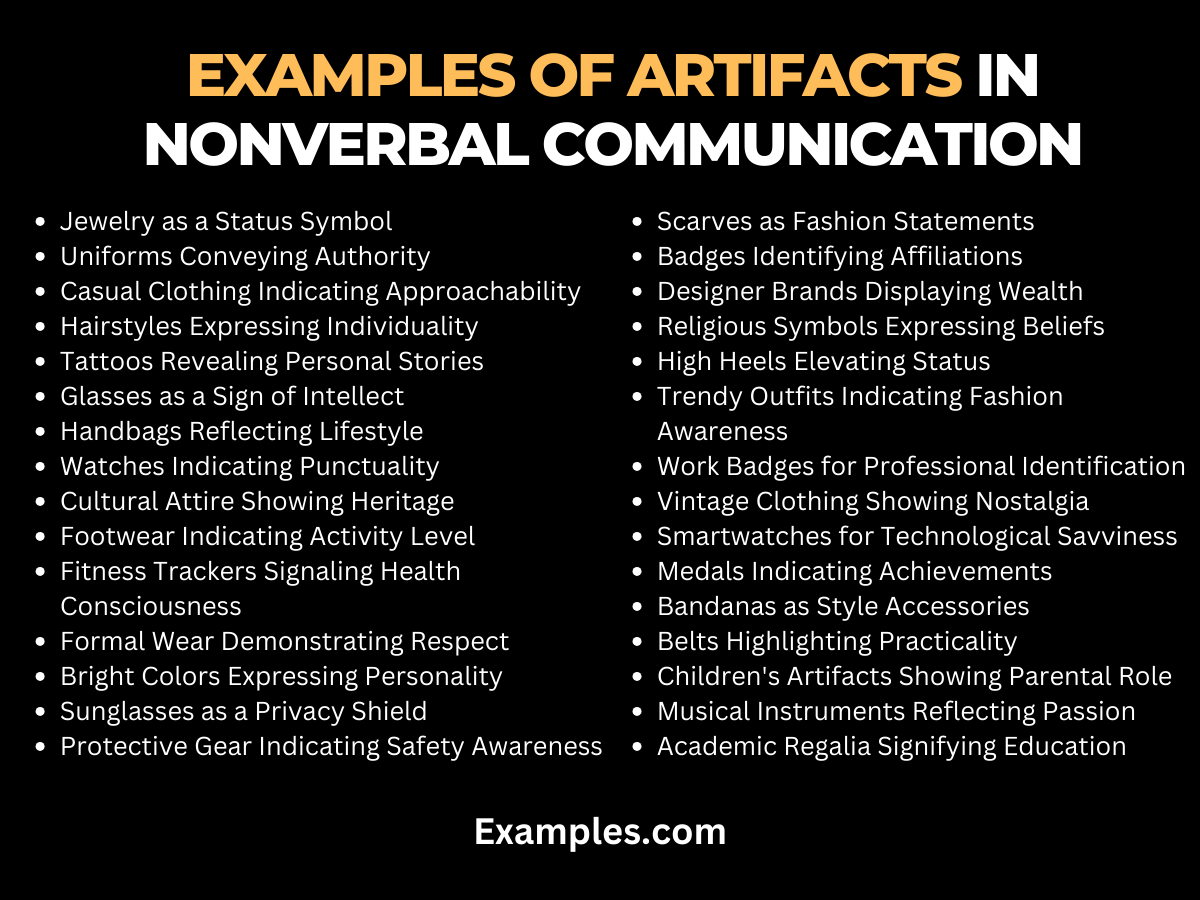Artifacts in Nonverbal Communication
Unlock the world of silent messages with this comprehensive guide on Artifacts in Nonverbal Communication. These personal objects speak volumes in our daily interactions, often without us even realizing it. From the way we dress to the accessories we choose, every item can be a powerful tool in conveying messages. This guide delves into various Communication Examples, offering insights into how these artifacts can be used effectively in nonverbal exchanges. Whether it’s in a professional setting or personal interactions, understanding the language of artifacts opens a new dimension in communication.
What are Artifacts in Nonverbal Communication?

Artifacts in Nonverbal Communication refer to personal objects used to express identity and communicate messages without words. These can range from clothing and jewelry to hairstyles and other personal adornments. They play a significant role in how we perceive and are perceived by others, often setting the tone for interactions and conveying subtle cues about our personality, social status, and even beliefs. Understanding the use of artifacts can enhance our ability to read and respond to nonverbal cues more effectively.
What is the Best Example of Artifacts in Nonverbal Communication?

One of the best examples of artifacts in Nonverbal Communication is the use of uniforms. Uniforms, whether in a professional, educational, or organizational context, immediately convey a wealth of information about the wearer’s role, authority, and association. They can create an atmosphere of trust, respect, and professionalism. For instance, a doctor’s white coat not only identifies their profession but also establishes a sense of expertise and reliability. Similarly, a student’s uniform can promote a sense of equality and belonging within an educational institution. These artifacts go beyond mere clothing; they are powerful tools of nonverbal communication that shape our interactions and perceptions in significant ways.
30 Examples of Artifacts in Nonverbal Communication

Understanding Nonverbal Communication is crucial in deciphering social interactions. Artifacts, personal objects we use or wear, play a significant role in this silent yet expressive language. They communicate identity, status, and even emotions without uttering a word. Discover how these silent symbols, from clothing choices to accessories, convey powerful messages in various contexts, enhancing the comprehension of nonverbal cues and their impact in daily life.
1. Jewelry as a Status Symbol: Expensive or unique jewelry often signifies wealth or a special status.
Example: Wearing a family heirloom ring to a reunion subtly communicates respect for tradition.
2. Uniforms Conveying Authority: Uniforms, such as those worn by police officers or doctors, instantly communicate their role and authority.
Example: A doctor in a white coat immediately gains trust and authority in a healthcare setting.
3. Casual Clothing Indicating Approachability: Casual attire can make an individual seem more approachable and relaxed.
Example: Dressing casually for a team meeting can create a more open and collaborative atmosphere.
4. Hairstyles Expressing Individuality: Hairstyles can be a form of self-expression, reflecting personality or cultural identity.
Example: Sporting an unconventional hair color can showcase creativity and individualism.

5. Tattoos Revealing Personal Stories: Tattoos often have personal meanings or stories behind them, revealing aspects of one’s life journey.
Example: A visible tattoo commemorating a significant event can spark conversations about personal history.
6. Glasses as a Sign of Intellect: Glasses can sometimes be perceived as a sign of intelligence or seriousness.
Example: Choosing to wear glasses at a conference might project a more intellectual image.
7. Handbags Reflecting Lifestyle: The type and size of a handbag can reflect a person’s lifestyle and priorities.
Example: Carrying a large, practical bag might indicate a busy, multifaceted lifestyle.
8. Watches Indicating Punctuality: Wearing a watch can be a sign that a person values punctuality and time management.
Example: Checking a wristwatch subtly communicates the importance of time in a meeting.
9. Cultural Attire Showing Heritage: Wearing cultural or traditional attire can be a proud display of one’s heritage.
Example: Dressing in traditional garments for a cultural festival expresses respect and pride in one’s roots.
10. Footwear Indicating Activity Level: The choice of footwear can indicate the wearer’s activity level or profession.
Example: Sporting athletic shoes might suggest a lifestyle oriented towards fitness and activity.
11. Fitness Trackers Signaling Health Consciousness: Wearing a fitness tracker suggests an interest in personal health and fitness.
Example: Sporting a fitness band at work can indicate a commitment to maintaining a healthy lifestyle.
12. Formal Wear Demonstrating Respect: Choosing to wear formal attire can show respect for an event or occasion.
Example: Donning a suit for a wedding signifies respect for the ceremony’s formality.
13. Bright Colors Expressing Personality: Opting for bright colors in attire can reflect a vibrant, energetic personality.
Example: Wearing a bright yellow dress can convey a cheerful and optimistic disposition.
14. Sunglasses as a Privacy Shield: Sunglasses can serve as a barrier, providing a sense of privacy in public spaces.
Example: Wearing sunglasses at an outdoor event can subtly signal a desire for personal space.
15. Protective Gear Indicating Safety Awareness: The use of protective gear shows awareness and prioritization of safety.
Example: Wearing a helmet while biking communicates a conscientious approach to personal safety.

16. Scarves as Fashion Statements: Scarves can be used to accessorize and add a unique touch to an outfit.
Example: A brightly patterned scarf can add a flair of creativity to a professional ensemble.
17. Badges Identifying Affiliations: Badges or pins can indicate affiliation with a group, cause, or organization.
Example: Wearing a charity badge can subtly show support and raise awareness for a cause.
18. Designer Brands Displaying Wealth: Wearing designer brands can be a way of displaying wealth or a preference for luxury.
Example: Carrying a designer handbag can subtly communicate a taste for high-end fashion.
19. Religious Symbols Expressing Beliefs: Religious symbols, like a cross necklace or a hijab, express personal faith and beliefs.
Example: Wearing a religious emblem can quietly communicate spiritual commitment and identity.
20. High Heels Elevating Status: High heels can be perceived as elevating one’s social or professional status.
Example: Choosing to wear high heels at a business meeting can project confidence and formality.
21. Trendy Outfits Indicating Fashion Awareness: Wearing the latest fashion trends can indicate a keen interest in current styles.
Example: Sporting the latest fashion trend shows adaptability and awareness of current cultural norms.
22. Work Badges for Professional Identification: Displaying a work badge can immediately identify one’s professional role and organization.
Example: A visible employee badge at a conference aids in networking and professional recognition.
23. Vintage Clothing Showing Nostalgia: Wearing vintage clothing can express a fondness for past eras and styles.
Example: Dressing in vintage attire for a themed event can evoke a sense of nostalgia and appreciation for history.
24. Smartwatches for Technological Savviness: Sporting a smartwatch can indicate an affinity for technology and modern conveniences.
Example: Using a smartwatch in a meeting can subtly show a tech-savvy and efficient approach to tasks.
25. Medals Indicating Achievements: Displaying medals or awards can showcase personal achievements and honors.
Example: Wearing a marathon medal post-race communicates pride in personal athletic accomplishments.
26. Bandanas as Style Accessories: Bandanas can be a stylish accessory that adds a casual or edgy element to an outfit.
Example: Incorporating a bandana into an outfit can suggest a relaxed and creative personal style.
27. Belts Highlighting Practicality: Belts, beyond their functional use, can also be style statements reflecting practicality.
Example: Choosing a distinctive belt for an outfit can enhance a look while emphasizing functionality.

28. Children’s Artifacts Showing Parental Role: Parents often carry children’s artifacts like toys or baby supplies, indicating their role as caregivers.
Example: Having a child’s drawing in a workspace can tenderly indicate one’s identity as a parent.
29. Musical Instruments Reflecting Passion: Carrying a musical instrument can reflect a passion for music and artistic pursuits.
Example: Bringing a guitar to a gathering can express a deep interest in music and performing arts.
30. Academic Regalia Signifying Education: Wearing academic regalia during ceremonies signifies educational achievements.
Example: Donning a graduation cap and gown symbolizes the culmination of academic efforts and success.
Importance of Artifacts in Nonverbal Communication
Artifacts, personal objects we use to express our identity and culture, play a crucial role in nonverbal communication. They can include clothing, jewelry, tattoos, and even technology. Understanding their importance is key to deciphering the unspoken messages in our interactions. Here are eight points illustrating the significance of artifacts in nonverbal communication:
- Identity Expression: Artifacts are powerful tools for expressing personal identity. They can reflect one’s cultural background, personal interests, and beliefs. For example, wearing traditional attire can communicate pride in one’s heritage.
- Status and Power Indicators: Certain artifacts signify status and power. Expensive watches or designer clothing can indicate economic status, while uniforms and badges can denote professional rank or affiliation.
- Cultural Symbols: Artifacts often serve as cultural symbols, conveying meanings specific to a particular group. Religious symbols, national colors, or tribal jewelry can communicate a wealth of information about cultural affiliations.
- Personal Style and Individuality: The choice of artifacts can reveal much about a person’s style and individuality. This aspect of nonverbal communication allows for a silent yet expressive form of self-presentation and personal branding.
- Mood and Psychological State: The selection and arrangement of personal artifacts can also communicate one’s mood or psychological state. For instance, a meticulously dressed individual might convey meticulousness or formality, while a more casually dressed person might suggest relaxation or approachability.
- Social Norms and Conformity: Artifacts can reflect adherence to or rebellion against social norms. Uniforms, for instance, demonstrate conformity, while unconventional fashion choices might suggest non-conformity.
- Contextual Relevance: The context in which artifacts are used also contributes to their meaning in nonverbal communication. For example, wearing a business suit in a professional setting conveys a different message than wearing the same suit at a casual gathering.
- Changing Trends: The significance of artifacts in nonverbal communication evolves with changing fashion and cultural trends. This dynamic aspect means that the interpretation of these nonverbal cues can vary over time and across different societal groups.
Role of Artifacts in Nonverbal Communication
In the realm of nonverbal communication, artifacts are not merely passive objects but active participants that convey messages about their users. Here are eight detailed points on the role of artifacts in nonverbal communication:
- Enhancing Personal Image: Artifacts are often used to enhance or alter one’s personal image. This can range from the use of makeup to alter physical appearance, to the selection of clothing that aligns with a desired image or persona.
- Communicating Professionalism: In professional settings, artifacts like business attire, name tags, or even the technology one uses, communicate levels of professionalism and competence. They help in forming initial impressions that can influence professional interactions.
- Social and Cultural Connectivity: Artifacts act as connectors in social and cultural contexts, often being used to signal membership in certain groups or adherence to specific cultural norms. Wearing a sports team’s merchandise, for example, immediately connects individuals with fellow fans.
- Facilitating Nonverbal Cues: Artifacts can also aid in the delivery of other nonverbal cues. Gestures with personal objects, like adjusting glasses or the way one handles a pen, can add emphasis or convey attitudes subtly.
- Symbolizing Personal Values: Personal artifacts can symbolize values and beliefs. A recycled tote bag, for instance, might indicate environmental consciousness, while a religious pendant may communicate spiritual values.
- Influencing Interpersonal Dynamics: The choice of artifacts can influence interpersonal dynamics. The presence of certain objects can create barriers (like a desk between two people) or facilitate openness (like casual attire promoting a relaxed atmosphere).
- Conveying Nonverbal Messages in Specific Contexts: In specific contexts, artifacts can convey precise nonverbal messages. For example, Rings in a marital context communicate commitment, while academic regalia at a graduation ceremony symbolizes achievement and transition.
- Assisting in Nonverbal Expression for the Differently-Abled: For individuals with communication challenges, artifacts like communication boards or specialized technology play a vital role in facilitating nonverbal expression and interaction.
In conclusion, the profound impact of artifacts in nonverbal communication is undeniable. These personal objects, ranging from clothing and jewelry to hairstyles and tattoos, serve as a silent yet expressive language in our daily interactions. They are not just mere accessories but carry significant weight in how we are perceived and how we perceive others. Uniforms, for example, are a striking illustration of this, instantly conveying information about the wearer’s role, authority, and association, thus shaping our interactions and perceptions.
Moreover, the role of the physical environment in nonverbal communication, encompassing aspects like proxemics and chronemics, complements the influence of personal artifacts. The environment, defined broadly as any place or setting, contributes significantly to the nuances of nonverbal exchanges. This encompasses not just the personal space we maintain but also extends to interior designs, furniture arrangement, and even the ambient conditions of our surroundings.
Understanding these silent messages, both through personal artifacts and the environment, is crucial for effective communication. They play a pivotal role in shaping our interactions, whether in personal or professional settings. Recognizing and interpreting these nonverbal cues enhances our ability to navigate social interactions more effectively. For a deeper understanding of the role of nonverbal communication in social interactions, consider exploring the comprehensive insights provided by Social Sci LibreTexts. Additionally, to further delve into how our environment influences communication, the detailed exploration on Social Sci LibreTexts offers valuable perspectives.



